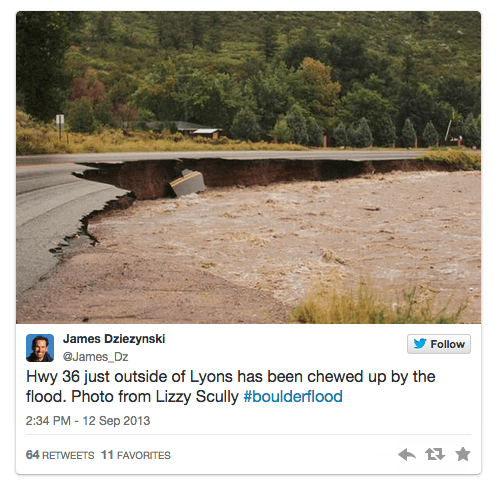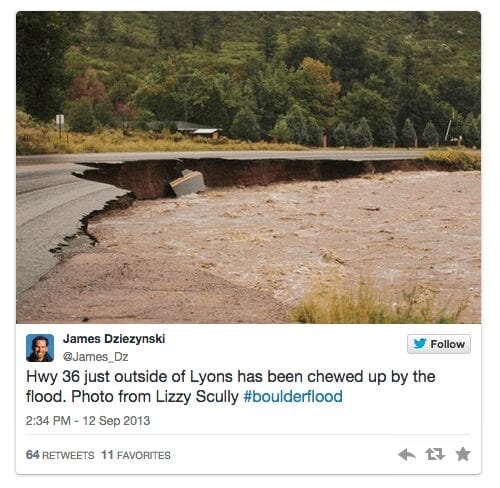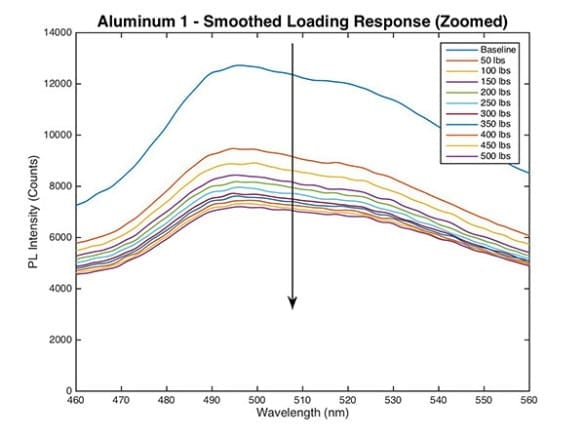
Tweets sent during last year’s massive flooding on Colorado’s Front Range were able to detail the scope of damage to the area’s infrastructure, according to a study by the University of Colorado Boulder.
The findings can help geotechnical and structural engineers more effectively direct their reconnaissance efforts after future natural disasters—including earthquakes, tsunamis and tornadoes—as well as provide them data that might otherwise be lost due to rapid cleanup efforts.
“Because the flooding was widespread, it impacted many canyons and closed off access to communities for a long duration, making it difficult to get a reconnaissance team on the ground,” said Shideh Dashti, an assistant professor of civil, environmental and architectural engineering at CU-Boulder and an author of the paper. “The continued storms also prevented airborne reconnaissance. As a result, social media and other remote sources of information were used to obtain reconnaissance information.
“People were tweeting amazing pictures and videos of damage to bridges and other infrastructure systems,” Dashti said. “After the fact, we compared those tweets to the damage reported by engineering reconnaissance teams and they were well correlated.”
During the second week of September 2013, the Front Range was deluged with as much as 17 inches of rain, causing extensive flooding that destroyed roads, swept away houses and washed out bridges.
After a disaster like last year’s floods, it’s important for geotechnical and structural engineers to collect data about how well infrastructure withstood the extreme event, in order to prevent damage in future similar disasters. Structures are designed to survive a certain amount of stress, but those built-in safety margins are based on mathematical formulas that attempt to describe the real world. Detailed information about what actually happens on the ground during disasters allows engineers to tweak the mathematical formulas and build more resilient infrastructure in the future.
The Latest on: Data on infrastructure damage
[google_news title=”” keyword=”Data on infrastructure damage” num_posts=”10″ blurb_length=”0″ show_thumb=”left”]
via Google News
The Latest on: Data on infrastructure damage
- Damaged energy facilities, fires, water woes: Fallout from Russia's Ukraine assaulton April 27, 2024 at 1:47 am
During today's massive rocket attack, the primary targets of Russian invaders once again were Ukraine's energy infrastructure objects. Specifically, the enemy targeted energy facilities in three ...
- Which Data Security Strategies Safeguard Businesses Against Potential Threats?on April 26, 2024 at 3:17 pm
Which Data Security Strategies Safeguard Businesses Against Potential Threats? In the age of Big Data, safeguarding sensitive information is a top priority for businesses. We’ve gathered insights from ...
- AI predicts infrastructure damage from disasterson April 26, 2024 at 2:52 am
Japanese telco NTT has used machine learning to develop AI which predicts damage to outdoor communications infrastructure during disasters such as ...
- Russian Missile Strike In Ukraine Injures Six, Damages Civilian Infrastructureon April 25, 2024 at 3:34 am
A Russian missile strike has caused severe damage to civilian and railway infrastructure in Ukraine’s Cherkasy ... system exploits the extensive Benzinga Ecosystem, including native data, APIs, and ...
- Monthly chart: Ukraine braces for tough summer months as Russia renews attacks on energy infrastructureon April 23, 2024 at 5:22 am
Russia carried out another large-scale attack on Ukraine's energy infrastructure — the third since the beginning of 2024 — destroying the Trypillia thermal power plant, the largest such plant near ...
- Broadband installation the leading cause of underground infrastructure damageon April 22, 2024 at 1:30 pm
That's according to a brief released last week by North Star Policy Action, an independent research organization. Jake Schwitzer, the executive director of North Star, shared more of the findings and ...
- Greensparc Brings Reliable, Powerful Computing Infrastructure to Cordovaon April 18, 2024 at 10:04 am
A new data center in Cordova brings cloud computing infrastructure to a remote community while soaking up surplus hydropower.
- Climate change damage could cost $38 trillion per year by 2050, study findson April 17, 2024 at 8:11 am
Damage to farming, infrastructure, productivity, and health from climate change will cost an estimated $38 trillion per year by 2050, German government-backed research finds, a figure almost certain ...
- Russian infrastructure disrupted by Ukrainian hackerson April 16, 2024 at 6:27 am
Operations of Russia's industrial sensor and monitoring infrastructure were claimed to have been disrupted by Ukrainian hacking operation Blackjack following a Fuxnet malware attack against ...
- Destructive ICS Malware ‘Fuxnet’ Used by Ukraine Against Russian Infrastructureon April 15, 2024 at 5:59 am
ICS malware Fuxnet allegedly used by Ukrainian hackers to disrupt industrial sensors and other systems belonging to a Russian firm.
via Bing News











